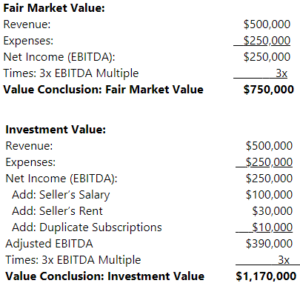30 Oct Understanding Fair Market Value vs. Investment Value
Written by: Todd Kutcher
(4 – 6 minute read)
In the world of finance and real estate, two key concepts often arise when determining the worth of an asset: fair market value (FMV) and investment value. Although these terms are sometimes used interchangeably, they represent distinct ideas that can lead to different valuations depending on the context. Understanding the differences between FMV and investment value is crucial for lenders, investors, buyers, sellers, and appraisers.
Fair Market Value (FMV)
Fair market value is defined by the Internal Revenue Service (IRS) in its Revenue Ruling 59-60 as, “the price at which the property would change hands between a willing buyer and a willing seller when the former is not under any compulsion to buy and the latter is not under any compulsion to sell, both parties having reasonable knowledge or relevant facts.” In essence, FMV is the most probable price that an asset will fetch in an open and competitive market.
Key Characteristics:
1. Market Conditions: FMV assumes a well-functioning, open market with no external pressures influencing the transaction.
2. Buyer and Seller: Both parties are assumed to be knowledgeable and not under duress, making rational decisions. FMV also assumes a hypothetical buyer and seller and does not consider any synergies.
3. Purpose: FMV is commonly used for taxation, legal proceedings, and general valuation where market conditions are a prime consideration.
Application: Consider a full-service restaurant in a suburban neighborhood. If similar restaurants in the area have recently sold for 3x current earnings, the FMV of this business would likely be around 3x current earnings, assuming no unique conditions affect its value. This valuation reflects the amount a hypothetical buyer would reasonably expect to pay and a hypothetical seller would reasonably expect to receive in the current market.
Illustrative Example
An accounting book of business is being sold to a local competitor. The buyer (an accountant of several decades) intends to integrate the seller’s book of business into her current practice as follows:
1. Eliminate the seller’s role ($100,000 salary) as the seller works 20 hours per week and primarily maintains client relationships.
2. Move all employees into her current office which is two miles from the seller’s current location. This will eliminate rent of $30,000 per year.
3. Eliminate duplicate subscriptions (estimated at $10,000 per year) at no additional cost.
After considering the following adjustments, the values under each standard are as follows:

As shown above, the value conclusion derived from using the Investment Value standard of value is much greater than the fair market value conclusion, despite no change in the EBITDA multiple.
SBA Context/Closing Remarks
At the time of this publication, the SBA Standard Operating Procedures do not state which value the lender should use, however, the SBA has previously stated that the lender should choose and fully understand the standard of value they are requesting. Typically, fair market value is used for SBA related business valuations due to SBA lenders’ tendency to rely on historical results over buyer forecasts, which reduces overall risk. However, in certain instances, a fair market value conclusion may yield a lower value due to the lack of synergies accounted for by a particular buyer. Investment value would factor in a specific buyer’s ability to improve margins or increase revenue through operational efficiencies and synergies from his or her existing businesses, which would materially affect the Company’s operations. Any client engaging in an investment value report should fully understand the considerations made under each standard of value and should be aware that the conclusions made under investment value could overstate the value of a subject business if they are not obtainable by the buyer being considered.
Both fair market value and investment value are essential concepts in asset valuation, but they serve different purposes and are based on different principles. Understanding these distinctions allows for more informed decision-making whether you’re buying, selling, or evaluating assets in the market. Reliant ensures that any client engaging in an investment value report fully understands the difference between each standard of value and the difference in conclusions from each, as valuation results can differ substantially based on the standard of value utilized in an engagement.


